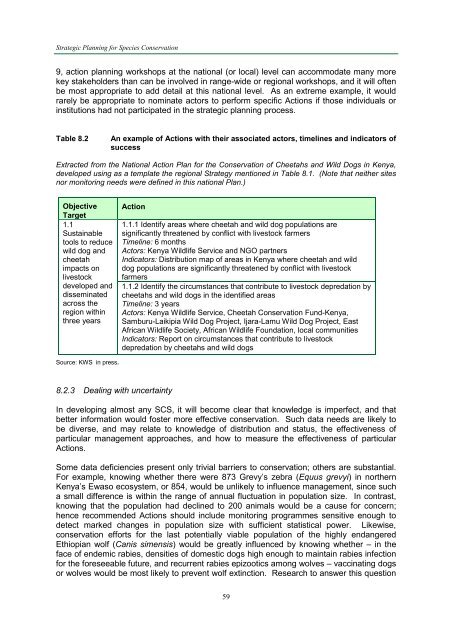Strategic Planning for Species Conservation: A Handbook - IUCN
Strategic Planning for Species Conservation: A Handbook - IUCN
Strategic Planning for Species Conservation: A Handbook - IUCN
You also want an ePaper? Increase the reach of your titles
YUMPU automatically turns print PDFs into web optimized ePapers that Google loves.
<strong>Strategic</strong> <strong>Planning</strong> <strong>for</strong> <strong>Species</strong> <strong>Conservation</strong><br />
9, action planning workshops at the national (or local) level can accommodate many more<br />
key stakeholders than can be involved in range-wide or regional workshops, and it will often<br />
be most appropriate to add detail at this national level. As an extreme example, it would<br />
rarely be appropriate to nominate actors to per<strong>for</strong>m specific Actions if those individuals or<br />
institutions had not participated in the strategic planning process.<br />
Table 8.2 An example of Actions with their associated actors, timelines and indicators of<br />
success<br />
Extracted from the National Action Plan <strong>for</strong> the <strong>Conservation</strong> of Cheetahs and Wild Dogs in Kenya,<br />
developed using as a template the regional Strategy mentioned in Table 8.1. (Note that neither sites<br />
nor monitoring needs were defined in this national Plan.)<br />
Objective<br />
Target<br />
1.1<br />
Sustainable<br />
tools to reduce<br />
wild dog and<br />
cheetah<br />
impacts on<br />
livestock<br />
developed and<br />
disseminated<br />
across the<br />
region within<br />
three years<br />
Source: KWS in press.<br />
Action<br />
8.2.3 Dealing with uncertainty<br />
1.1.1 Identify areas where cheetah and wild dog populations are<br />
significantly threatened by conflict with livestock farmers<br />
Timeline: 6 months<br />
Actors: Kenya Wildlife Service and NGO partners<br />
Indicators: Distribution map of areas in Kenya where cheetah and wild<br />
dog populations are significantly threatened by conflict with livestock<br />
farmers<br />
1.1.2 Identify the circumstances that contribute to livestock depredation by<br />
cheetahs and wild dogs in the identified areas<br />
Timeline: 3 years<br />
Actors: Kenya Wildlife Service, Cheetah <strong>Conservation</strong> Fund-Kenya,<br />
Samburu-Laikipia Wild Dog Project, Ijara-Lamu Wild Dog Project, East<br />
African Wildlife Society, African Wildlife Foundation, local communities<br />
Indicators: Report on circumstances that contribute to livestock<br />
depredation by cheetahs and wild dogs<br />
In developing almost any SCS, it will become clear that knowledge is imperfect, and that<br />
better in<strong>for</strong>mation would foster more effective conservation. Such data needs are likely to<br />
be diverse, and may relate to knowledge of distribution and status, the effectiveness of<br />
particular management approaches, and how to measure the effectiveness of particular<br />
Actions.<br />
Some data deficiencies present only trivial barriers to conservation; others are substantial.<br />
For example, knowing whether there were 873 Grevy’s zebra (Equus grevyi) in northern<br />
Kenya’s Ewaso ecosystem, or 854, would be unlikely to influence management, since such<br />
a small difference is within the range of annual fluctuation in population size. In contrast,<br />
knowing that the population had declined to 200 animals would be a cause <strong>for</strong> concern;<br />
hence recommended Actions should include monitoring programmes sensitive enough to<br />
detect marked changes in population size with sufficient statistical power. Likewise,<br />
conservation ef<strong>for</strong>ts <strong>for</strong> the last potentially viable population of the highly endangered<br />
Ethiopian wolf (Canis simensis) would be greatly influenced by knowing whether – in the<br />
face of endemic rabies, densities of domestic dogs high enough to maintain rabies infection<br />
<strong>for</strong> the <strong>for</strong>eseeable future, and recurrent rabies epizootics among wolves – vaccinating dogs<br />
or wolves would be most likely to prevent wolf extinction. Research to answer this question<br />
59

















